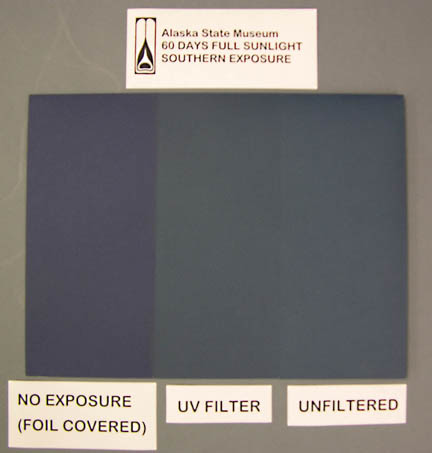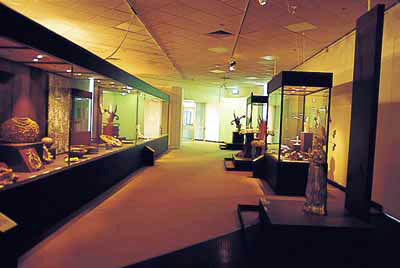UV Detector 
This detector contains UV detecting beads inside a clear plastic tube. When the detector is shielded from UV radiation, the beads are white. When exposed to UV radiation (between 360 and 300 nm in wavelength), the beads turn purple. The color intensity of the beads depends on the amount of UV present. This detector can change color thousands of times.
|
Light Emitting Diodes Replacing Conventional Museum Lighting
Light Emitting Diodes (LEDs) have recently become widely available and cost-effective, due to technology improvements. Tungsten filament bulbs, our well-known incandescent bulb, produces light by heating a filament until it glows. This is not energy efficient - much electricity is used to create heat. LEDs have no filament. Their light comes from moving electrons from one energy state to another. Thus a higher percentage of the electricity goes to generating light, so less electricity is needed. Comparing two bulbs that use the same amount of electricity (watts), the LED is as much as seven times brighter. Because there is no filament, LEDs last longer, too. According to Design Recycle Inc, they can last 50,000 hours. To understand how these lights work, read How Light Emitting Diodes Work from the "How Stuff Works" website. Lighting performance measures have not caught up to these new lights. There is no industry standard test procedure for rating the performance of LED devices or packages, nor is there design uniformity between fixtures, according to the U.S. Department of Energy's Office of Energy Efficiency and Renewable Energy. They have produced a number of excellent articles about LEDs to clarify how well they work and how they match more traditional lights:
Can Museums Measure Up?
LED Luminaire Reliability
Guide to Evaluating LED Lumen Maintenance
LED Replacements for Four-Foot Linear Fluorescent Lamps
Luminaire Efficacy
|
Smithsonian Offers a Free Preservation Webcast
On Tuesday, March 5, 2013, the Smithsonian Institution presents a one-day symposium and webcast on the preservation environment. Learn from experts about the latest research on the museum preservation environment as well sustainable museum environment concepts and tips for collaboration among collections, exhibition, and facilities staff. This program is part of an internal discussion at the Smithsonian regarding strengthening collaboration and collections. The Smithsonian is sharing the information with colleagues around the world with a webcast. The program will also be video archived and documented with a publication.
Summit program and webcast live is available at http://www.si.edu/PreservationEnvironment
Following the one-day symposium, there will be a Smithsonian-only event where colleagues from the museum, archives, and library field discuss opportunities for improving Smithsonian approaches to identifying environmental parameters for collections. This will also be captured in the publication and disseminated to the museum field.
|

In March we offer the final 2013 course for the National Association of Tribal Historic Preservation Officers (NATHPO):
Students must be staff at a tribal institution and meet NATHPO qualifications. These courses are subsidized by the Institute of Museum and Library Services through a grant awarded to NATHPO.
To be considered for one or both of the courses, fill out the online application at: http://nathpo.org/NNMTP/onlineclassesApplication.html
|
Regional Workshops
Where you can find some of our instructors this year:
Steve Layne
Certified Institutional Protection Manager
- March 10, 2013, The Midwest Security Conference, Lisle, IL
- May 18, 2013, AAM Annual Meeting, Baltimore, MD
IFCPP Conference
- August 3-7, 2013, San Diego, CA
Helen Alten
Disaster Preparedness Workshop
- June 14-15, 2013, Athens, Greece.
Collections Management and Practices
- July 11-12, 2013, Bryn Mawr College, Bryn Mawr, PA, $270 AASLH members/$345 nonmembers. $40 discount if fee received by June 5.
|
|
|
Welcome to the Collections Caretaker e-Newsletter from Northern States Conservation Center. The newsletter is designed to bring you timely and helpful content that is pertinent to situations we all encounter in our museum and archives work. Feel free to let us know what topics you would like to see featured in Collections Caretaker or even contribute an article.
|
|
Light Fading from UV
By Ellen Carrlee

This plain paper folder was placed in a window with southern exposure at the Alaska State Museum for two months. The far left side was covered with aluminum foil to block out all light. The middle third was covered with UV filtering plastic film. This film was tested with a UV light meter to insure it was effective at blocking ultraviolet light. The far right hand side of the paper folder was left completely exposed.
On my computer monitor (and on the real folder) you can see a slight difference in the faded blue color between unfiltered and filtered, but both are drastically faded from the section that was not exposed to light at all. Hopefully this is evident on your computer monitor as well.
While filtering UV light does eliminate a dangerous wavelength of light that is contributing to deterioration beyond just fading, if you seek to prevent the visual change of your colors from light fading, UV filtering will not give you the protection you need. All light is damaging, and fading is cumulative and irreversible. To prolong the vividness of colors, you must bring light levels down and limit overall exposure, not merely filter for UV light.
Reprinted from Ellen Carrlee Conservation Blog, November 5, 2010.
Ellen Carrlee received an M.A. in Art History and Diploma in Conservation from New York University in 2000, specializing in ethnographic and archaeological objects. She then completed a Mellon Fellowship at the National Museum of the American Indian. She has been the Conservator at the Alaska State Museums since 2006. |
A Summary of Exhibition Lighting
By Lin Nelson-Mayson
1. Types of lighting methods
Lighting plays an important role in the experience visitors have with exhibitions. Too little light is unpleasant and can be a safety hazard. However, too much light is also unpleasant and a conservation hazard. The impact of light in museum environments has been the subject of much research into intensity, sources and exposure times. Daylight, once a primary source of illumination in many museums, has largely been replaced by incandescent, fiber-optics and other light-emitting sources. Making light safer for a wide range of materials has also been the goal of conservation studies on types of lights and exposure times.
In general, daylight is comfortable for visitors, but can cause significant damage to materials such as paper and fabrics due to high amounts of UV radiation. Daylight can be limited to public areas with "transition areas" between areas brightly lit by natural light and dimmer areas of artificial light. Fluorescent lighting also contains high UV emissions and is not recommended for exhibition areas, but is often used in work areas with UV filters on the light fixtures of individual tubes.
Incandescent lighting is the most common method of gallery lighting. Spots and floods are used with dimmers in track or recessed systems to illuminate galleries and individual objects. Spots are used with or without diffusers to highlight individual objects or components. Floods cast a broader area of light and are best used for illuminating larger areas of a wall, big objects, or in providing general illumination so that visitors can see where they are going!
 | | Selecting the right lighting includes deciding whether daylight, fluorescent light, track lights, incandescent lights or flexible fiber optics will provide what you need for preservation and viewing. |
2. Material lighting requirements
Conservation studies have determined that UV should be eliminated or severely restricted. Limit light exposure by intensity and time. In general, use the lowest levels possible for effective and safe illumination and employ techniques to limit or reduce light when possible. Some particularly sensitive areas may benefit from the installation of motion sensors that turn on the lights when a visitor approaches. The following ICOM chart gives general recommendations for light levels for various materials.
Material Type Maximum Luminance Recommended
(lux)
metal, stone, glass, ceramics, not restricted but rarely
stained glass, jewelry, enamel necessary to exceed 300
(color temperature 4000-6500K)
oil and tempera painting, 150-180 in service
natural leather, horn, bone, (color temperature ca. 4000K)
ivory, wood and lacquer
textiles, costumes, watercolors, 50 (less if possible)
tapestries, prints and drawings, (color temperature ca. 2900K)
stamps, manuscripts, miniatures,
gouaches, dyed leather
One of the key issues to prepare for in setting the light levels for various materials is the light effect on visitors' eyes in going from a lighter area to a dimmer one. As mentioned in the previous section, transitions need to be developed between a brightly-lit area, such as an entry lobby, and dimmer areas, such as a gallery with prints or costumes. Within a gallery, a bright area, such as a window or bare bulb, will draw the visitors' eyes to it and will make visual adjustment to a dimmer area difficult. Transitions can be developed through a sequence of rooms leading from bright to dark, but can also be managed in a more modest space by placing a temporary wall just inside the entrance to the gallery. The wall will block the brighter light, provide transition lighting as the visitor moves around it to enter the gallery, and the title of the exhibition can be installed on the front of the wall, developing the introduction to the contents of the gallery.
3. Controlling natural light
Despite the beauty of natural light, it is inherently harmful to most materials due to its high UV content. In a museum setting, it is important to limit exposure of objects to natural light through careful location of objects and use of window coverings to limit or omit exposure to daylight. Ideally, a public space can be situated to take advantage of the daylight, with galleries located in more protected areas.
Window coverings can range from blinds or curtains to scrims and UV-blocking films. Blinds and curtains, like those in our homes, can be adjusted based on the materials exhibited and can be matched to the character of the gallery or room. Often curtains are the most historically appropriate window coverings. UV-blocking film is a common product in areas that receive a great deal of sun and can be applied to the windows of most historic houses without changing the architectural character of the structure. Scrims, or solar screens, are also useful tools in controlling daylight. Simple scrims can be constructed by stretching muslin over a frame designed to fit the window. Solar screen is a dense, open-weave fabric that can cover windows allowing visitors to see outside, but restricting incoming sunlight and heat. A popular feature for patios in warm climates, solar screens can be used in combination with UV film to block light and heat without entirely denying the architectural existence of windows. This can be the compromise for museums in older structures that enables exhibitions to be mounted in former parlors or living rooms and light to be reduced to manageable levels.
Excerpt from MS 106: Exhibit Fundamentals: Ideas to Installation.
Lin Nelson-Mayson, with over 25 years of museum experience at small and large institutions, is director of the University of Minnesota's Goldstein Museum of Design. Prior to that, she was the director of ExhibitsUSA, a nonprofit exhibition touring organization that annually tours over 30 art and humanities exhibitions across the country. For five years, she was a coordinator or judge for the American Association of Museums' Excellence in Exhibitions Competition. She currently serves on the exhibition committee for the National Sculpture Society. Ms. Nelson-Mayson has extensive experience with the planning, preparation, research and installation of exhibitions. Ms Nelson-Mayson's experience includes teaching museum studies and museology courses. Her particular interest is the needs of small museums. |
Archives Storage
by Susan Duhl
Good storage is the first and best means of defense in safely preserving archival holdings and is a major component of preventive conservation. Preparation and a premeditated strategic plan define the archive's steps and priorities to develop a safe, secure, organized, efficient, and well maintained storage facility. Planning will also predict required staff, equipment and funding needs.
Phased Projects
Undertaking progressive or "phased" projects allows improvements to occur in priority order and as staff time and funding become available. Steps in developing storage and workrooms include:
- Select, design, and equip the best possible space.
- Use museum specialists in room selection, space design, furniture, use and access.
- Locate a structurally and mechanically secure area of the building.
- Locate the archives facility in a specific, separate and secure area.
- Locate collections away from heating, ventilating and air conditioning equipment. Isolate all air-handling units in separate rooms. Consulting with a museum-specialist engineer is strongly advisable.
- Control the temperature, light and humidity at appropriate and stable levels to ensure the preservation of materials. Paper is a very sensitive material. This means it is reactive both chemically and physically to its surroundings and affected by fluctuating or extreme temperature, relative humidity and light levels, as well as poor handling, adverse exhibition conditions, biological infestations and disasters of all sizes.
- Temperatures are recommended at levels between 68 degrees Fahrenheit and 72 degrees Fahrenheit. It is most important to limit fluctuations to a range of 5 degrees Fahrenheit. Seasonal changes are less damaging than rapid (hourly or daily) fluctuations. Increased temperatures will accelerate the rate of paper deterioration and may also promote desiccation (drying out) of paper structures.
- Relative Humidity (RH) levels are recommended at 50% - 55%. Relative humidity is a term that describes the amount of water vapor in a gaseous mixture of air and water vapor. It is the amount of water in the air relative to the total amount of water that the air can hold at that temperature. Paper will expand in increased RH and contract in lower RH. While minimal expansion and contraction is expected, extreme conditions can cause permanent structural damages and media problems. RH is read using hygrometers. Many types of hygrometers are available.
Excerpt from MS234: Archives Management. March is the only time the course will be offered in 2013. Susan Duhl is an Art Conservator in private practice specializing in art on paper and archival collections. She provides workshops, preservation consultations and conservation treatment to institutions and private individuals throughout the world. Susan treats works on paper, including prints, watercolors, drawings, wallpaper, documents, and 3-dimensional paper objects. Her work includes disaster response and recovery, consultations and collection surveys to determine condition, treatment and long-term care recommendations, and helping clients prioritize treatment needs. Her recent clients include the Library of Congress and the National Archives and Records Administration.Susan completed her Master of Art degree and Certificate of Advanced Study in Art Conservation from the State University College at Buffalo Art Conservation Program. She is a Professional Associate of the American Institute for Conservation of Historic & Artistic Works (AIC) and founding member of the Art Conservators Alliance.
|
Northern States Conservation Center (NSCC) provides training, collection care, preservation and conservation treatment services. NSCC offers online museum studies classes at www.museumclasses.org in Collections Management & Care, Museum Administration & Management, Exhibit Practices and Museum Facilities Management.
Sincerely,
Helen Alten, DirectorBrad Bredehoft, Sales and Technology Manager Peggy Schaller, Publications Manager
|
|
|
|
|
|
|



